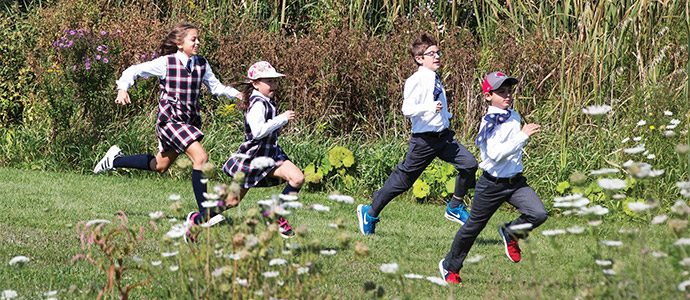Private School
5 min Read
Outdoor education: The new classroom

September 23, 2018
Private School
5 min Read

September 23, 2018

When Betsy McConnell entered high school, she says she struggled with negative body issues, put a lot of effort into trying to be perfect and always second-guessed herself. The outdoor education program at Lakefield College School built up her confidence – especially the grade 11 winter camping trip.
“It completely changed my perception of myself,” says McConnell. “It was really interesting to realize how everything does work together in my body to keep me alive, and that the things my body can do are pretty incredible.”
The impossible goal of perfection went out the window, too.
“When you’re in a survival scenario,” says McConnell, “you learn you don’t need to be perfect at every outdoor skill, you just need to be good enough – and that it’s important to work with other people and use everyone’s skills.”
The eastern Ontario high school’s outdoor education coordinator – and OE instructor for 16 years – is Pete Andras. He says he fell in love with the philosophy of outdoor education and goal-setting through challenges of survival, such as the wilderness first aid component in grade 11. It includes students taking part in a simulation of a plane crash on the large waterfront campus. “They assume it’s a remote location and they are the only chance to pull people out,” says Andras.
Complementing the experience is classroom study of anatomy and body systems. Learning throughout the school year culminates in students enacting a final crisis simulation – this time with much more knowledge – and earning wilderness first aid certification.
“That’s how we do education well,” says Andras.
Outdoor education can be delivered in different ways. The common theme is that it involves being outside and it’s experiential.
Natural spaces provoke inquiry, says James Willms, a grade five teacher and coordinator of outdoor, experiential and ecological education at Meadowridge School in Maple Ridge, B.C. The junior kindergarten to grade 12 school sits on a campus that includes a 10-acre forest with a creek running through it. He says the fact students can just spill out into the natural space is conducive to the eco-literacy focus of outdoor education at Meadowridge. Willms says kids who emotionally connect to the natural systems around us (and understand how they function) are more likely to take care of the environment later.
How do you get kids to love their environment and gain a sense of place? By making it lots of fun. Hiding games are wildly popular.
“The kids love it. What they don’t realize is while they’re hiding, they’re seeing tiny creatures, bugs crawling on the ground, and they’re getting a smell and getting to know the place.”
Willms says as kids continue to inquire – learning, for instance, about how the runoff from neighbourhood streets flows into the stream, impacting wildlife – a desire to protect their environment grows. It’s reinforced further through projects such as growing food sustainably in the school’s greenhouse and garden spaces.
At Country Day School in King City, Ont., Stephanie Collins oversees and teaches the OE program for junior students.
“We’re sitting on a hundred acres,” says Collins. “The Oak Ridges Moraine runs through our property, so we can go out and see the marshlands and the red wing blackbirds out on the bulrushes.”
Collins says outdoor education allows for kinesthetic learning (connecting physical movement with study), reinforcing concepts by strengthening neural pathways in the brain. During the grade six solar system unit, students go outside to move like the Earth. “We look at the 45-degree tilt and they have to move their bodies that
way and rotate and orbit around the sun.”
Collins co-plans with classroom teachers and spends her instructional time outside in 80-minute stints per four-day cycle.
Her colleague, Andy MacMillan, heads the middle and senior OE programs, creating outdoor experiences for multiple subjects.
A traditional canoe trip with students was joined by the art teacher, for instance, and parlayed into a painting session ‘en plein air’ on an island in northern Ontario’s Lake Temagami. Writing prose about their outdoor surroundings in different seasons augmented learning in English class. And when it came time to study World War II trench life in grade 10 history? MacMillan had kids dig trenches, then simulate defending them and communicating on the battlefield.
“The kids who really get jazzed are the ones who don’t necessarily want to read 15 pages. They want to make it real,” says MacMillan. “It got their hands and feet muddy!”
Studies show that exposure to the natural world affects well-being. Collins says she likes to take her students outside for a hike or to sit under a tree when she knows it’s a busy time for them.
“They know going for a hike might benefit them if they’re feeling stressed or overwhelmed,” she says. “It’s giving them those tools for when they’re an adult.”
Meadowridge teacher Willms remembers taking a group of students in the spring for an overnight hiking trip. The kids were inexperienced, and it was cold and rainy the whole time. At a campfire that night, the kids started sharing how they felt less stressed.
“They were worried about having somewhere to sleep, how to make their supper, and staying warm,” he says. “But that was all they had to worry about. They said it was so refreshing.”
You learn a lot more than outdoor skills on such adventures, says Lakefield’s Pete Andras.
“You learn how to be a person. We’ll go on a canoe trip and a meal isn’t so tasty. Or you’re winter camping and the quinzee keeps falling apart. The group has to think ‘how are we going to survive?’ ”
Betsy McConnell says that connecting deeply with other people, text-free, is a huge bonus of outdoor education.
“Some of the best conversations I’ve had with people, some of the deepest friendships, have been on those outdoor trips.”